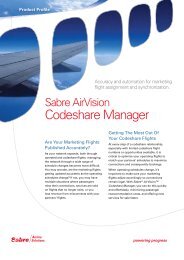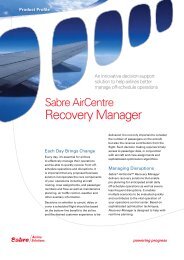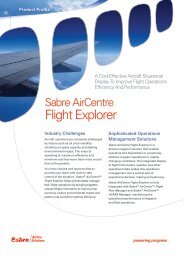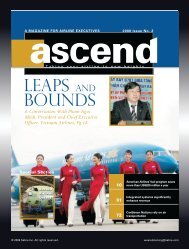2009 Issue 1 - Sabre Airline Solutions
2009 Issue 1 - Sabre Airline Solutions
2009 Issue 1 - Sabre Airline Solutions
You also want an ePaper? Increase the reach of your titles
YUMPU automatically turns print PDFs into web optimized ePapers that Google loves.
compatibility considerations<br />
Once the potential partnership type<br />
is identified, airlines should examine how<br />
well they will work in conjunction with one<br />
another. Three key areas for evaluation<br />
include:<br />
1. Network compatibility,<br />
2. Business compatibility,<br />
3. System compatibility.<br />
To examine these issues, decision<br />
makers should evaluate potential partners<br />
by asking several questions in each of the<br />
key areas:<br />
Network compatibility<br />
Coverage — Will the partnership enlarge<br />
market reach to meet the demand?<br />
Connectivity — How well will flights connect<br />
at hubs of all partners?<br />
Capacity share — Will the joint capacity<br />
dominate the local trunk market?<br />
Business compatibility<br />
Service levels and branding — If the partner<br />
is a low-cost carrier, does its services<br />
match those of a premium carrier or vice<br />
versa?<br />
Corporate culture — How entrenched is<br />
the culture, and how easily will it accommodate<br />
a partners culture?<br />
Products — What cabin classes, in-flight<br />
services and frequent flyer programs<br />
does the potential partner offer?<br />
Financial stability — Is the airline willing<br />
to take on a troubled partner? What will<br />
it cost?<br />
system compatibility<br />
Reservations and ticketing systems —<br />
Does the partner system enable free sell<br />
and interline e-ticketing?<br />
Revenue accounting system — Can the<br />
potential partner handle the type of interline<br />
billing system the operating carrier<br />
handles?<br />
Check-in systems — Can the potential<br />
partner handle interline through checkin?<br />
Web sites — Does the partner system<br />
have the ability to display, reserve and<br />
ticket codeshare flights and multi-leg<br />
interline itineraries in top travel portals<br />
and partner Web sites?<br />
When integrating information technology<br />
systems with other carriers, the<br />
key is to use the right systems that work<br />
well and directly impact the customer. The<br />
primary integration point is with the passenger<br />
services systems. A reservation<br />
made by a marketing airline must be present<br />
in the inventory from the operating carrier’s<br />
system. Items such as frequent flyer<br />
traveler numbers, seat assignments and<br />
special service requests need to be present<br />
and synchronized in both the operating<br />
and marketing carriers’ systems. The best<br />
method for doing this is using one of the<br />
four industry standard codeshare options<br />
that have been developed for electronic<br />
communication between airline reservations<br />
systems. The other best practice from<br />
a customer perspective is frequent traveler<br />
miles. Best practice is to consistently send<br />
data feeds to and from loyalty systems.<br />
Newer and more open systems also<br />
help attract partners because the implementation<br />
will be easier, faster and less<br />
expensive. These types of systems also<br />
often mean more sales opportunities and<br />
better customer service.<br />
revenue sharing<br />
Once a potential partner is analyzed,<br />
it should be determined how revenue will<br />
be shared. Rather than using the standard<br />
IATA prorate methodology, most airlines<br />
in a codeshare arrangement will create a<br />
HiGHlight<br />
It’s fair to say that<br />
since the dawn of the<br />
21st century, economic<br />
conditions have<br />
nibbled away at the<br />
pie known as the<br />
airline industry.<br />
special prorate agreement with their partner<br />
carrier. This enables more flexibility<br />
in determining how the revenue will be<br />
split among partners. An analysis of an<br />
SPA should take into account the potential<br />
new traffic from the codeshare and the<br />
potential displacement of passengers and/<br />
or revenue on the existing flights.<br />
The key to success in setting up an<br />
SPA is that there is fairness and balance.<br />
An airline needs to balance the potential<br />
revenue displacement of carrying a codeshare<br />
passenger in a busy market with<br />
the additional opportunity of adding an<br />
additional codeshare passenger in a more<br />
lightly traveled market. In short, SPAs need<br />
to be beneficial to both partners.<br />
Once the SPA has been finalized, the<br />
next step is to determine how the booking<br />
classes will be aligned between the carriers.<br />
Each operating carrier is responsible<br />
for managing its own inventory, so when<br />
the marketing carrier requests a seat on<br />
the operating carrier, the operating carrier<br />
needs to know how to tell the marketing<br />
carrier if the seat is available or not.<br />
The process is handled using translation<br />
tables set up in the reservations<br />
system. Each operating carrier reviews the<br />
prorate agreement to determine where it<br />
will point the marketing carrier’s booking<br />
classes to its own. Ideally, the revenue<br />
received by the operating carrier in a booking<br />
class from the codeshare passenger<br />
should be the same as the revenue the<br />
operating carrier would expect from its<br />
own customers.<br />
effect on the traveling Public<br />
Generally, airline agreements have<br />
a positive impact on the traveling public.<br />
Passengers have more choices of flights<br />
and itineraries to reach the same destination.<br />
If the partnership does its job,<br />
travelers will find a seamless integration<br />
between carriers from booking to check-in<br />
to post-flight services.<br />
While partnerships get the kinks out,<br />
however, travelers may be confused by different<br />
flight numbers for the same flights<br />
displayed on airport screens and heard in<br />
announcements. In addition, frequent flyer<br />
numbers may not be automatically credited<br />
by partners, and passengers may have<br />
to manually fax the document to partner<br />
airlines.<br />
However, airline executives are betting<br />
that customers will endure the shortterm<br />
hardships when they realize the result<br />
will be far more travel choices within an<br />
alliance than they would have with an individual<br />
airline.<br />
It’s the travel choices that will ultimately<br />
drive more brand loyalty to both the<br />
airline and the alliance. a<br />
Lynne Clark can be contacted<br />
at wearelistening@sabre.com.<br />
Thomas Bertram and Philip Wang<br />
are consultants for <strong>Sabre</strong> <strong>Airline</strong><br />
<strong>Solutions</strong> ® . They can be contacted<br />
at thomas.bertram@sabre.com<br />
and philip.wang@sabre.com.<br />
ascend<br />
49<br />
special section
















